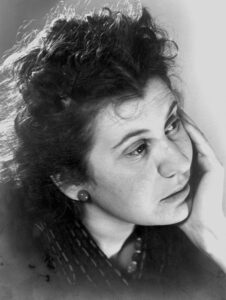One of the most extraordinary personal accounts of keeping the light shining in the darkness comes from the diary and letters of Etty Hillesum. She began her diary in 1941 when she was 27 years old. She wrote about her life as a Jewish woman in The Netherlands, including her inner personal work with Julius Speier, a palm-reading psychologist for whom she later worked and entered into a relationship with. In 1942 and again in 1943, she was taken to Westerbork concentration camp – a transit camp in the northeastern Netherlands – the last stop before Auschwitz for more than one hundred thousand Dutch Jews.
Many will be familiar with her book ‘An Interrupted Life: the diaries and letters of Etty Hillesum’ which also documents her developing spiritual consciousness and belief in God. It is a testimony to love and faith written in the very darkest of recent times: ‘Everything is so mysterious and strange, and so full of meaning, too.’
Still in Amsterdam, Etty Hillesum wrote in a letter to a friend:
‘One day when there is no more barbed wire left in the world, you must come and see my room. It is so beautiful and peaceful. I spend half my night at my desk reading and writing to the light of my small lamp. I have about 1,500 pages of a diary from last year … What a rich life leaps out at me from every page. To think that it was my life – and still is.’
Although, decades later, there is still barbed wire, and high walls keeping people apart from one another all over the world, Westerbork camp with its sickness, overcrowding, noise, fear and despair has been grassed over. Its history is chronicled in the museum and remembrance centre now located there, and Etty Hillesum’s words and inspiration showing such courage and humanity live on. She was determined to share the fate of her fellow Jews without despair, and also without bravado knowing well that she would not survive – ‘willing to act as a balm for all wounds’. And, in the hell of Westerbork Etty Hillesum was able to write: ‘Despite everything, life is full of beauty and meaning.’
‘The earth is in me, and the sky. And I well know that something like hell can also be in one, though I no longer experience it in myself, but I can still feel it in others with great intensity … And when the turmoil becomes too great and I am completely at my wits end, then I still have my folded hands and bended knee … my story … the girl who learnt to pray.’
One of the ways that Etty Hillesum carries a light in the darkness is her capacity to hold both the horror and the beauty in a deeply uncomfortable tension of opposites, as in this extract from one of her letters, where she comments on a transportation leaving for Auschwitz:
‘Just now I climbed on a box lying among the bushes here to count the freight cars. There were thirty-five …The freight cars had been completely sealed, but a plank had been left out here and there, and people put their hands through the gaps and waved as if they were drowning.
The sky is full of birds, the purple lupins stand up so regally and peacefully … the sun is shining on my face – and right before our eyes, mass murder. The whole thing is simply beyond comprehension.’
